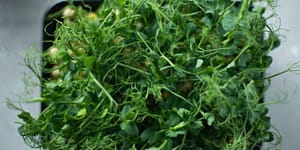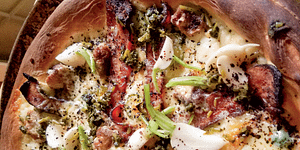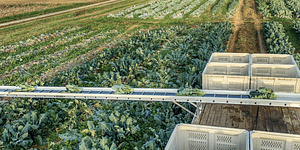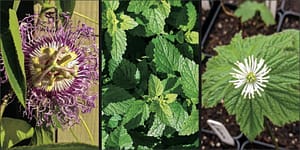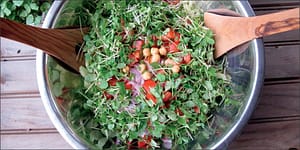Interplanting and Beyond
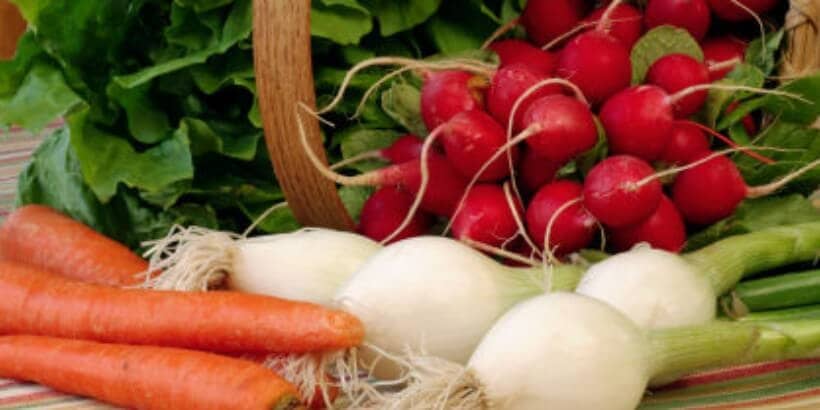
Permaculture is more than just a way to garden, it applies systems-thinking to every facet of our relationship to the earth and each other. The three main ethics of permaculture are care for the planet, care for people, and only keeping a fair share of the yields of your productive work (gardening and otherwise). Expanding outward from these seemingly simple statements are a plethora of intricate methods for mimicking natural systems in gardening, building, planning, and community organization. Using different veggies’ strengths and weaknesses to avoid competition and maybe even get them to help each other out is called interplanting. It’s a planting strategy that adds up to one big happy vegetable family—think of it as a square-foot salad.
The following is an excerpt from Gaia’s Garden: A Guide to Home-Scale Permaculture by Toby Hemenway. It has been adapted for the web.
Vegetable gardeners have some experience in creating plant communities. Food-growers have long attempted to avoid the drawbacks, both aesthetic and ecological, of large blocks of a single crop. Monocultures deplete the soil, provide a sumptuous feast for pests, and dull the senses. To avoid these faults, many gardeners practice interplanting, mixing different varieties together to save space and avoid solid clumps of one vegetable. Interplanting strategies, while usually limited to vegetables, illustrate some of the principles of combining varieties that work together to deter pests and aid each other in other ways. Once we’ve learned the basics of interplanting, we can broaden our spectrum and look beyond vegetables toward garden plant communities that benefit not just people but all of nature.

An interplant of lettuce, onions, and carrots, which allows dense planting while avoiding competition for nutrients and sunlight. Illustration by Elayne Sears.
One simple interplanting scheme mixes onions, carrots, and lettuce in the same garden bed. These three plants have different leaf forms, light requirements, and rooting depths, which makes them compatible both physically and in terms of their resource needs. The cylindrical leaves of onions grow virtually straight up, casting little shade. Feathery carrot leaves bush out a bit but don’t create deep shadows.
Lettuce, although it forms a solid mass of greenery, is short and casts its shade below the other plants. The three leaf forms fit well together, allowing ample sunlight to bathe each plant. Also, lettuce needs less sun than onions and carrots, so the slight shade cast by the latter two won’t impede lettuce’s growth. In summer, lettuce tends to bolt and taste bitter unless shaded, which is a good reason to grow it beside taller plants.
And, lastly, the roots of these three plants don’t compete for space: Onions are shallow rooted, lettuce reaches to an intermediate depth, and the taproots of carrots go deep but straight down. Each searches for nutrients in a different place. These three vegetables, with their varying shapes, light requirements, and rooting patterns, can be interplanted very successfully.
Other combinations: Interplanting Brussels sprouts, parsley, spinach, and onions is effective because the spinach and onions are ready before the sprouts mature, and the parsley can tolerate some shade. Also, their root depths and nutrient needs are divergent. Radishes, lettuce, and peppers work well for similar reasons; the radishes grow fast, the lettuce doesn’t mind the shade of the young peppers, and by the time the peppers are full-grown, the other plants have been harvested.
Though interplanting saves space, it doesn’t go far enough for me. Most interplanting, as in the above examples, simply combines plants to avoid negative interactions, such as competition for space or light. This form of interplanting doesn’t blend plants into dynamic, interactive associations the way nature does. What’s more, interplanting rarely capitalizes on the mutual benefits plants can provide each other, such as deterring pests or transporting and storing nutrients.
A second technique, companion planting, takes advantage of some of these mutual benefits. For example, planting sage near carrots reputedly repels the carrot fly. Carrots themselves are thought to exude a substance that stimulates the growth of peas. Companion planting is a step in the right direction; but, unfortunately, many traditional combinations turn out, in careful trials, to provide no benefit at all. Surprisingly, some old recipes even produce detrimental effects.

Hence, without supporting data I’m skeptical of planting basil alongside tomatoes in the hopes of getting bigger beefsteaks—to choose an old-time companion recipe at random. Companion planting in its highest form can create beautiful mixed beds of flowers and vegetables. In its simplest and most common mode, however, companion planting merely combines plants in what is not far from monoculture: nice orderly beds of two or perhaps three species—static, perfectly weeded, and ecologically dead.
We can do better.
Recommended Reads
Recent Articles
If you’re ready to start growing a portion of your own food, but you aren’t quite ready for something that requires a big time commitment or a lot of effort, this is a good place to start. Sprouts are easy to cultivate, mature very quickly, can be used in a variety of delicious dishes, and…
Read MoreNothing says “spring” like a fresh, foraged meal! Savor the flavors of the season with this Milkweed Bud Pizza recipe.
Read MoreSo you want to start reaping your harvest, but you’re not sure where to start? Learn how to break down the options of harvesting tools!
Read MoreWant to start your own medicinal herb garden? Passionflower, lemon balm, and goldenseal are great places to begin! These herbs are jam-packed with medicinal properties and easy to grow in a majority of climates.
Read MoreDoes the cold weather have you dreaming about fresh greens and colorful salad? Grow and harvest sprouts indoors to make those dreams a reality! Follow this quick start guide to year-round greens for fresh salad greens in just a couple of weeks! The following is an excerpt from Year-Round Indoor Salad Gardening by Peter Burke. It…
Read More




